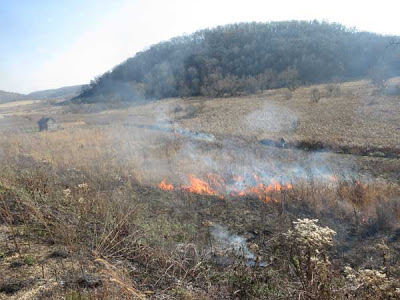Making fire break for spring burn
Yesterday afternoon was a delightful day, warmish and sunny, and proved a good time to improve a fire break we will use for a spring burn. Experience has shown that making fire breaks in the fall is always a good idea.
The fire break we worked on is in the woods on the north side of Toby's Prairie. This is an area where there was a big aspen clone that we girdled and removed in the late 1990s. These aspen had moved into what had been a white/red oak woods, and when we removed the aspen we left the oaks. Since this area is adjacent to a prairie, it made sense to burn both the woods and prairie at the same time. However, for the past several years the burn crew has managed to burn only the prairie, and the site was starting to fill up with brush. This next spring, and from now on, we will be burning both the prairie and woods together.
As the second photo shows, we are running the fire break just above a point where there is a sharp change in topography. Historically, the field that is now Toby's Prairie was plowed just to this point (as shown with GIS by the 1937 air photo). That was back in the days when horses were used to plow. Post World-War II, when a tractor became available, it was no longer possible to plow so far down the hill. (Tractors tend to get stuck in the mud in these north-facing areas.) Left alone, it gradually filled in with oaks, some of which are now quite large. The aspen clone came later, moving out of the former plowed field and down the hill.
We aren't burning in order to turn this area into a prairie or savanna, but we do want to control the brush (hazel, willow, gray dogwood) which is invading in a major way. As can be seen by the photos, there are plenty of oak leaves to provide fuel.
In the spring, all we will need to do is make a quick pass along this fire break with a leaf blower and it should be ready to go.
 |
| We used both a brush cutter and chain saw. All of the cut stems/stumps were treated with Garlon 4. |
The fire break we worked on is in the woods on the north side of Toby's Prairie. This is an area where there was a big aspen clone that we girdled and removed in the late 1990s. These aspen had moved into what had been a white/red oak woods, and when we removed the aspen we left the oaks. Since this area is adjacent to a prairie, it made sense to burn both the woods and prairie at the same time. However, for the past several years the burn crew has managed to burn only the prairie, and the site was starting to fill up with brush. This next spring, and from now on, we will be burning both the prairie and woods together.
As the second photo shows, we are running the fire break just above a point where there is a sharp change in topography. Historically, the field that is now Toby's Prairie was plowed just to this point (as shown with GIS by the 1937 air photo). That was back in the days when horses were used to plow. Post World-War II, when a tractor became available, it was no longer possible to plow so far down the hill. (Tractors tend to get stuck in the mud in these north-facing areas.) Left alone, it gradually filled in with oaks, some of which are now quite large. The aspen clone came later, moving out of the former plowed field and down the hill.
We aren't burning in order to turn this area into a prairie or savanna, but we do want to control the brush (hazel, willow, gray dogwood) which is invading in a major way. As can be seen by the photos, there are plenty of oak leaves to provide fuel.
In the spring, all we will need to do is make a quick pass along this fire break with a leaf blower and it should be ready to go.











